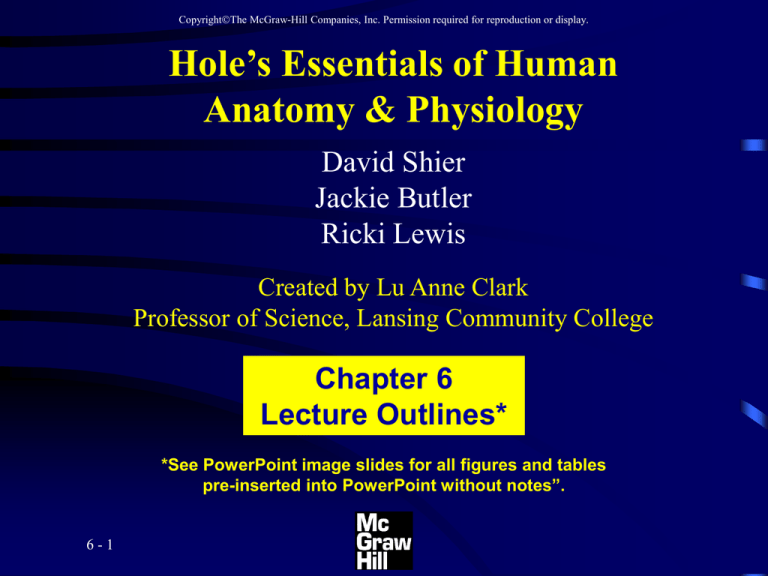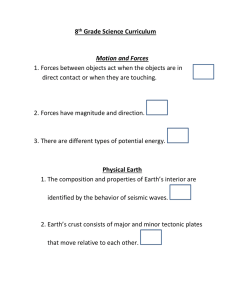Hole’s Essentials of Human Anatomy & Physiology Chapter 6 Lecture Outlines*
advertisement

CopyrightThe McGraw-Hill Companies, Inc. Permission required for reproduction or display. Hole’s Essentials of Human Anatomy & Physiology David Shier Jackie Butler Ricki Lewis Created by Lu Anne Clark Professor of Science, Lansing Community College Chapter 6 Lecture Outlines* *See PowerPoint image slides for all figures and tables pre-inserted into PowerPoint without notes”. 6-1 Chapter 6 Skin and the Integumentary System 6-2 CopyrightThe McGraw-Hill Companies, Inc. Permission required for reproduction or display. • Introduction: A. Organs are body structures composed of two or more different tissues. B. The skin and its accessory organs make up the integumentary system. 6-3 CopyrightThe McGraw-Hill Companies, Inc. Permission required for reproduction or display. Types of Membranes A. Serous membranes line body cavities that lack openings to the outside. 1. They line the thorax and abdomen and cover the organs within these cavities. 2. Serous membranes are made up of epithelium and loose connective tissue and secrete serous fluid that acts as a lubricant. 6-4 CopyrightThe McGraw-Hill Companies, Inc. Permission required for reproduction or display. B. Mucous membranes line the cavities and openings that lead to the outside of the body, including the oral and nasal cavities, and openings of the digestive, reproductive, respiratory, and urinary systems. 1. 6-5 They consist of epithelium and connective tissue with specialized cells that secrete mucus. CopyrightThe McGraw-Hill Companies, Inc. Permission required for reproduction or display. C. Synovial membranes line the joint cavities. 1. These membranes consist of only connective tissues and they secrete lubricating synovial fluid. D. The cutaneous membrane consists of the skin, and is the subject of the remainder of this chapter. 6-6 CopyrightThe McGraw-Hill Companies, Inc. Permission required for reproduction or display. Skin and Its Tissues A. The skin is a large organ responsible for maintaining homeostasis through temperature regulation, protection of underlying tissues, retardation of water loss, housing sensory receptors, synthesizing certain chemicals, and excreting wastes. 6-7 CopyrightThe McGraw-Hill Companies, Inc. Permission required for reproduction or display. B. The skin consists of an outer epidermis and a dermis, connected to underlying tissue by the subcutaneous layer (hypodermis). 6-8 CopyrightThe McGraw-Hill Companies, Inc. Permission required for reproduction or display. C. 1. 2. 6-9 Epidermis The epidermis is made up of stratified squamous epithelium and lacks blood vessels. The layer of reproducing cells (the stratum basale), which lies at the base of the epidermis, is well-nourished by dermal blood vessels. CopyrightThe McGraw-Hill Companies, Inc. Permission required for reproduction or display. 3. Cells are pushed outward as new cells are formed, and become keratinized as they die. Four or five layers may be seen: stratum basale, stratum spinosum, stratum granulosum, and stratum corneum are always present and the stratum lucidum is found in the thicker palms and soles. 6 - 10 CopyrightThe McGraw-Hill Companies, Inc. Permission required for reproduction or display. 4. 5. 6. 6 - 11 The epidermis is important because it protects against water loss, mechanical injury, chemicals, and microorganisms. Melanocytes, which lie deep in the epidermis and underlying dermis, produce a pigment called melanin that protects deeper cells from the sun's ultraviolet rays. Melanocytes pass melanin to nearby cells through cytocrine secretion. CopyrightThe McGraw-Hill Companies, Inc. Permission required for reproduction or display. D. 1. Skin Color Skin color results from a combination of genetic, environmental, and physiological factors. 2. Genetic differences in skin color result from differing amounts of melanin and in the size of melanin granules. 6 - 12 CopyrightThe McGraw-Hill Companies, Inc. Permission required for reproduction or display. 6 - 13 3. Exposure to sunlight causes darkening of skin as melanin production increases. 4. Circulation within dermal blood vessels affects skin color. CopyrightThe McGraw-Hill Companies, Inc. Permission required for reproduction or display. 6 - 14 E. Dermis 1. The dermis binds the epidermis to underlying tissues. Epidermal ridges and dermal papillae cause the border to be uneven. 2. The dermis consists of connective tissue with collagen and elastic fibers within a gel-like ground substance. CopyrightThe McGraw-Hill Companies, Inc. Permission required for reproduction or display. 6 - 15 3. Dermal blood vessels carry nutrients to upper layers of skin and help to regulate temperature. 4. The dermis also contains nerve fibers, sensory fibers, hair follicles, sebaceous glands, and sweat glands. CopyrightThe McGraw-Hill Companies, Inc. Permission required for reproduction or display. F. 6 - 16 Subcutaneous Layer 1. The subcutaneous layer (hypodermis) is composed of loose connective tissue and insulating adipose tissue. 2. It binds the skin to underlying organs and contains the blood vessels that supply the skin. 3. No sharp boundary exists between the dermis and subcutaneous layer. CopyrightThe McGraw-Hill Companies, Inc. Permission required for reproduction or display. Accessory Organs of the Skin A. Hair Follicles 1. Hair can be found in nearly all regions of the skin. 6 - 17 CopyrightThe McGraw-Hill Companies, Inc. Permission required for reproduction or display. 6 - 18 2. Individual hairs develop from cells at the base of the hair follicle, an invagination of the lower epidermis that dips down into the dermis. 3. As new cells are formed, old cells are pushed outward and become keratinized, and die forming the hair shaft. CopyrightThe McGraw-Hill Companies, Inc. Permission required for reproduction or display. 6 - 19 CopyrightThe McGraw-Hill Companies, Inc. Permission required for reproduction or display. 6 - 20 4. A bundle of smooth muscle cells, called the arrector pili muscle, attaches to each hair follicle. These muscles cause goose bumps when cold or frightened. 5. Hair color is determined by genetics; melanin from melanocytes is responsible for most hair colors, but red hair also contains the pigment trichosiderin. CopyrightThe McGraw-Hill Companies, Inc. Permission required for reproduction or display. B. 6 - 21 Sebaceous Glands 1. Sebaceous glands (holocrine glands) are associated with hair follicles and secrete sebum that waterproofs and moisturizes the hair shafts. CopyrightThe McGraw-Hill Companies, Inc. Permission required for reproduction or display. C. 6 - 22 Nails 1. Nails are protective coverings over the ends of fingers and toes. 2. Nails consist of stratified squamous epithelial cells overlying the nail bed, with the lunula as the most actively growing region of the nail root. 3. As new cells are produced, older ones are pushed outward and become keratinized. CopyrightThe McGraw-Hill Companies, Inc. Permission required for reproduction or display. D. 6 - 23 Sweat Glands 1. Sweat glands (sudoriferous glands) are either eccrine, which respond to body temperature, or apocrine, which respond to body temperature, stress, and sexual arousal. 2. Modified sweat glands, called ceruminous glands, secrete wax in the ear canal. 3. Mammary glands, another modified type of sweat glands, secrete milk. CopyrightThe McGraw-Hill Companies, Inc. Permission required for reproduction or display. Regulation of Body Temperature 6 - 24 A. Proper temperature regulation is vital to maintaining metabolic reactions. B. The skin plays a major role in temperature regulation with the hypothalamus controlling it. C. Active cells, such as those of the heart and skeletal muscle, produce heat. CopyrightThe McGraw-Hill Companies, Inc. Permission required for reproduction or display. D. Heat may be lost to the surroundings from the skin through radiation. E. The body responds to excessive heat by dilation of dermal blood vessels and sweating. The body responds to excessive cooling by constricting dermal blood vessels, inactivating sweat glands, and shivering. F. 6 - 25 CopyrightThe McGraw-Hill Companies, Inc. Permission required for reproduction or display. Healing of Wounds and Burns A. B. 6 - 26 Inflammation, in which blood vessels dilate and become more permeable, causing tissues to become red and swollen, is the body's normal response to injury. Superficial cuts are filled in by reproducing epithelial cells. CopyrightThe McGraw-Hill Companies, Inc. Permission required for reproduction or display. C. D. 6 - 27 Deeper cuts are closed off by clots, covered by scabs, and eventually filled in by fibroblasts, making connective tissue. Blood vessels extend into the area, injured tissues are replaced, and the scab falls off. Large wounds leave scars and healing may be accompanied by the formation of granulations.




